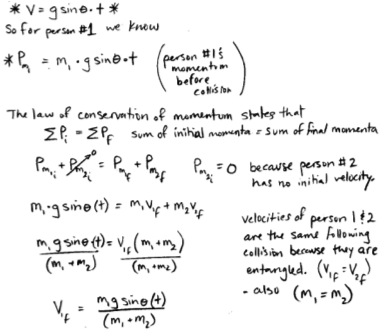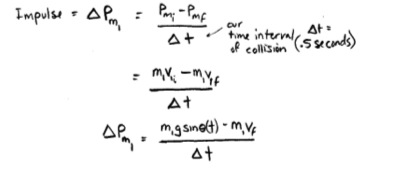Momentum
and Collisions
Collisions are a true hazard on
the slopes and prevention is one of the
main concerns of major ski resorts. Collisions with other riders and
stationary objects can cause life threatening injury, and every year
countless skiiers and snowboarders suffer head and neck injuries from
collisions with other slope goers ("U.S. Consumer Product Safety
Commision" 3-4). The cause of these head and neck
injuries are related to two physical concepts called momentum and
impulse.
Momentum is defined as mass x
velocity (P=mv), most know intuitively
know
what momentum is, but here we will be sure to break this concept into
the two components
that comprise it and disscuss thier reprecussions. The momentum
equation shows that an object's momentum increases with an increase in
mass or velocity.
Impulse is defined as either the time derivative of momentum (change in
momentum over a given time) or as
the time integral of the forces
acting on an object (the sum of forces acting over a given time
interval). To gain a
better perspective on what impulse
really is, consider the case of whiplash. When a passenger
experiences a car crash, the cabins' momentum undertakes a rapid
decrease in acceleration, velocity and therefore momentum. These
changes in acceleration and velocity are translated into forces which
cause injury. This abrupt change in
momentum is known as the impulse of force. Let's take a look
at impulse as it pretains to the world of snowboarding.
Let's visualize a collision with
two riders; one who is decending a
slope, and a rider who is at standstill further downhill. For the sake
of simplicity let
us depict these riders as blocks and assume that thier masses are
equal, let us also assume negligible friction. The velocity of person
#1 will be given by the equation
v=gsin(theta)(t) as was derived in our disscussion of energy
and gradients. Assume
that the time rider 1 has accumulated speed without slowing for 30
seconds on a gradient of 30°. We will
also assume that the collision is inelastic, that is the riders become
entangled following the crash for some time, lets say 0.5 seconds.

P=mv
From Energy and
gradients we know…

Now
let’s calculate ΔP
of mass 1, this will give
us
the acceleration
portion of
the force of impact.
Calculating
Impulse

Force
of Impact

These equations are potent tools
for examining impulse, but no
substitute for prevention. Impulse forces are a leading cause of head
injuries among riders of all
experience levels. To avoid serious and long term injuries
it is important to wear a helmet when trying out new tricks
and a good idea any other time. It is important for more
experienced riders to take initiative in looking over little ones and
less experienced riders
on the slopes. This occasionally means cutting the newbies and
boneheads a
break. Remember that your momentum is directly proportional to your
speed, so
slow down when approaching areas of high population on the
slopes.

Cats even wish they could
snowboard.
Stay safe and enjoy the ride.
Spins and
Flips: Inertia be Thy Guide
Back to Title




